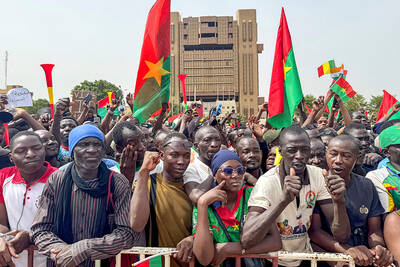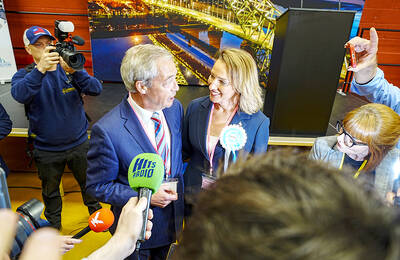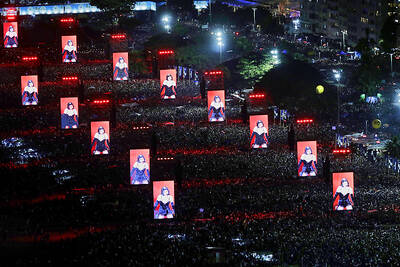It is still entwined in mystery and jungle vines, but one of Cambodia’s grandest monuments is slowly awakening after eight centuries of isolated slumber, having attracted a crack archeological team and a trickle of tourists.
“It takes a while to unfold this temple — and everywhere there are enticements,” team leader John Sanday says, as he navigates through tangled undergrowth, past dramatic towers and bas-reliefs and into dark chambers of the haunting monastic complex of Banteay Chhmar.
What drove Jayavarman VII, regarded as the greatest king of the Angkorian Empire, to erect this vast Buddhist temple about 170km from his capital in Angkor and in one of the most desolate and driest places in Cambodia remains one of its many unsolved riddles.
Called the “second Angkor Wat,” Banteay Chhmar approaches it in size, is more frozen in time than the manicured and made-over superstar, and has so far been spared the blights of mass tourism of recent years at Angkor.
Last year, an average of about 7,000 tourists a day visited Angkor, one of Asia’s top tourist draws located near the booming -northwestern city of Siem Reap.
Banteay Chhmar saw an average of two a day, with no tour buses and bullhorn-wielding guides to disturb the temple’s tranquility or life in the surrounding village.
Abandoned for centuries, then cut off from the world by the Khmer Rouge and a civil war, Banteay Chhmar did not welcome visitors until 2007, when the last mines were cleared and the looting that plagued the temple in the 1990s was largely halted.
A year later, the California-based Global Heritage Fund began work at the site under the overall control of the Cambodian Ministry of Culture and now spends about US$200,000 a year on the project.
Sanday, a veteran British conservation architect, assembled a team of 60 experts and workers, some of who worked with him on an earlier restoration of the Preah Khan temple at Angkor. Others were recruited from the surrounding community and although barely literate, Sanday says they are among the best he’s worked with in Asia.
Nature and time have proved the culprits: the vaulting protecting the 30m long relief collapsed, exposing the wall to monsoon torrents, which seeped downwards to wash away the masonry and loosen the foundations. Pressure from the weight above toppled sections of the wall or forced it to lean.
Nearby, two young Cambodian computer whizzes are pioneering a shortcut to the reassembly process through three-dimensional imaging. About 700 stone blocks from the tower have been removed or collected from where they fell and each one will be videographed from every angle. Since like a human fingerprint, no stone is exactly alike, still-to-be-finalized software should be able to fit all the blocks into their original alignment after they are repaired.
The Global Heritage Fund, is also intent on involving the community. “We cannot protect Banteay Chhmar. They have to be the protectors. So they must gain some revenue from the temple,” Sanday says.
The Community Based Tourism group, which the fund supports, is training locals to become guides and devising ways to derive more income from tourism, part of which is funneled into betterment of the entire village.
However, Sanday and local organizers hope Banteay Chhmar’s remote location will spare it from a mass tourist influx, which is why he does not want it listed as a UNESCO World Heritage Site, something the government is pushing for.

Kehinde Sanni spends his days smoothing out dents and repainting scratched bumpers in a modest autobody shop in Lagos. He has never left Nigeria, yet he speaks glowingly of Burkina Faso military leader Ibrahim Traore. “Nigeria needs someone like Ibrahim Traore of Burkina Faso. He is doing well for his country,” Sanni said. His admiration is shaped by a steady stream of viral videos, memes and social media posts — many misleading or outright false — portraying Traore as a fearless reformer who defied Western powers and reclaimed his country’s dignity. The Burkinabe strongman swept into power following a coup in September 2022

‘FRAGMENTING’: British politics have for a long time been dominated by the Labor Party and the Tories, but polls suggest that Reform now poses a significant challenge Hard-right upstarts Reform UK snatched a parliamentary seat from British Prime Minister Keir Starmer’s Labor Party yesterday in local elections that dealt a blow to the UK’s two establishment parties. Reform, led by anti-immigrant firebrand Nigel Farage, won the by-election in Runcorn and Helsby in northwest England by just six votes, as it picked up gains in other localities, including one mayoralty. The group’s strong showing continues momentum it built up at last year’s general election and appears to confirm a trend that the UK is entering an era of multi-party politics. “For the movement, for the party it’s a very, very big

ENTERTAINMENT: Rio officials have a history of organizing massive concerts on Copacabana Beach, with Madonna’s show drawing about 1.6 million fans last year Lady Gaga on Saturday night gave a free concert in front of 2 million fans who poured onto Copacabana Beach in Rio de Janeiro for the biggest show of her career. “Tonight, we’re making history... Thank you for making history with me,” Lady Gaga told a screaming crowd. The Mother Monster, as she is known, started the show at about 10:10pm local time with her 2011 song Bloody Mary. Cries of joy rose from the tightly packed fans who sang and danced shoulder-to-shoulder on the vast stretch of sand. Concert organizers said 2.1 million people attended the show. Lady Gaga

SUPPORT: The Australian prime minister promised to back Kyiv against Russia’s invasion, saying: ‘That’s my government’s position. It was yesterday. It still is’ Left-leaning Australian Prime Minister Anthony Albanese yesterday basked in his landslide election win, promising a “disciplined, orderly” government to confront cost-of-living pain and tariff turmoil. People clapped as the 62-year-old and his fiancee, Jodie Haydon, who visited his old inner Sydney haunt, Cafe Italia, surrounded by a crowd of jostling photographers and journalists. Albanese’s Labor Party is on course to win at least 83 seats in the 150-member parliament, partial results showed. Opposition leader Peter Dutton’s conservative Liberal-National coalition had just 38 seats, and other parties 12. Another 17 seats were still in doubt. “We will be a disciplined, orderly